The great blue heron (Ardea herodias) belongs to the heron family Ardeidae. The scientific name derives from the Latin word ardea and the Greek word erōdios, which both mean “heron.” It ranges throughout North and Central America, along with the Caribbean and Galápagos Islands. Due to its large stature and commanding presence, the great blue heron features prominently in art and also in popular culture. Today, we’ll discuss 10 incredible great blue heron facts and explore what makes this giant wading bird so fascinating.

10. Great Blue Herons Can Eat Up to 2 Pounds of Fish Per Day
For our first great blue heron fact, we’ll explore the diet of great blue herons. Great blue herons are carnivores that will eat just about anything that they can catch. You can typically find them wading through water in search of prey. Despite their large size, they usually prey on smaller fish, amphibians, reptiles, and mammals. Some of the foods great blue herons eat include crabs, snakes, frogs, mollusks, and shrimp.
Fish also make up a substantial portion of their diet. They eat a wide variety of fish, ranging from bass and carp to perch and minnows. Great blue herons are voracious eaters and frequently eat up to 2 pounds of fish per day, which equates to 25 to 50 percent of their body weight.
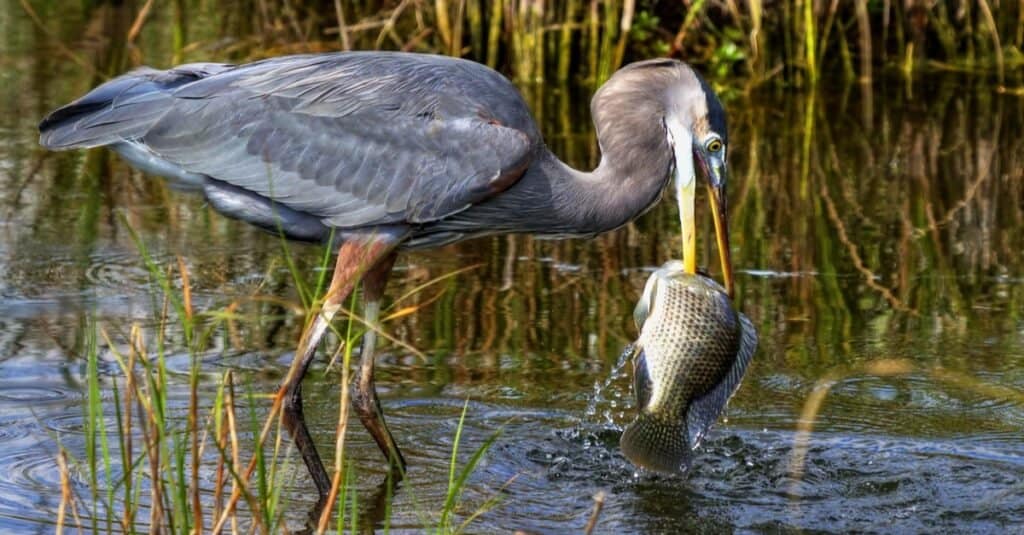
Great blue herons have massive appetites and eat a wide variety of fish.
©David Byron Keener/Shutterstock.com
9. Great Blue Herons Possess Excellent Vision
When we think of birds with great vision, we often think of eagles, hawks, or owls. However, great blue herons are no slouches when it comes to spotting their prey. Their eyes contain a high number of rod-type photoreceptors. They possess a binocular vision that gives them excellent depth perception, and their eyesight is about three times more detailed than that of humans.
Great blue herons have not only excellent daytime vision but nighttime vision as well. They can see almost as well at night as they can during the day. This trait benefits them greatly during their annual migration, as they typically start flying at night.
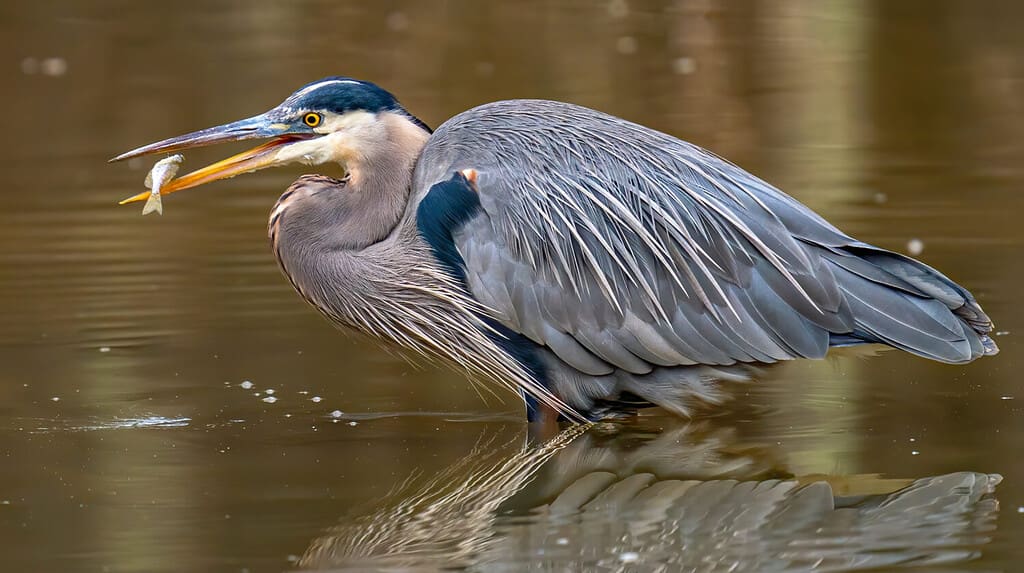
©Krumpelman Photography/Shutterstock.com
8. Great Blue Herons Are the Largest Herons in North America
Great blue herons get their name not only from their blueish-grey color but also from their large stature. Most specimens measure 36 to 54 inches from head to tail and stand between 45 and 54 inches tall. Their wingspan ranges from 66 to 79 inches, and they typically weigh between 4 and 8 pounds. On average, males measure larger than females, but the size difference is usually not noticeable.
Great blue herons are the largest herons native to North America. In fact, the only extended herons larger than the great blue heron are the goliath heron and white-bellied heron.
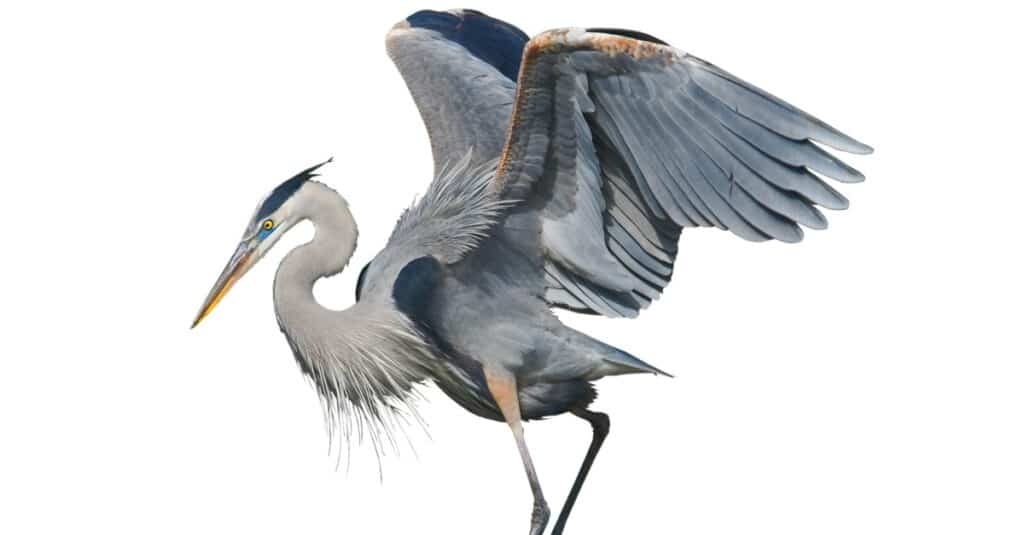
The wingspan of a great blue heron ranges from 66 to 79 inches.
©Tathoms/Shutterstock.com
7. Some Great Blue Herons Build Massive Nests
Great blue herons live in colonies that can contain up to 500 nests. That said, most colonies contain between 100 and 200 nests. They typically build their nests in hard-to-reach places such as islands, swamps, marshes, or tall trees. It’s not uncommon for them to build their nests at heights of up to 100 feet. However, if tall trees are not available, they may also build their nests on the ground.
Unlike some birds, which build a new nest every time they breed, great blue herons often reuse their nests. A first-year nest is typically smaller and only measures around 20 inches in diameter. However, a nest that is several years old may measure up to 4 feet wide and almost as deep.
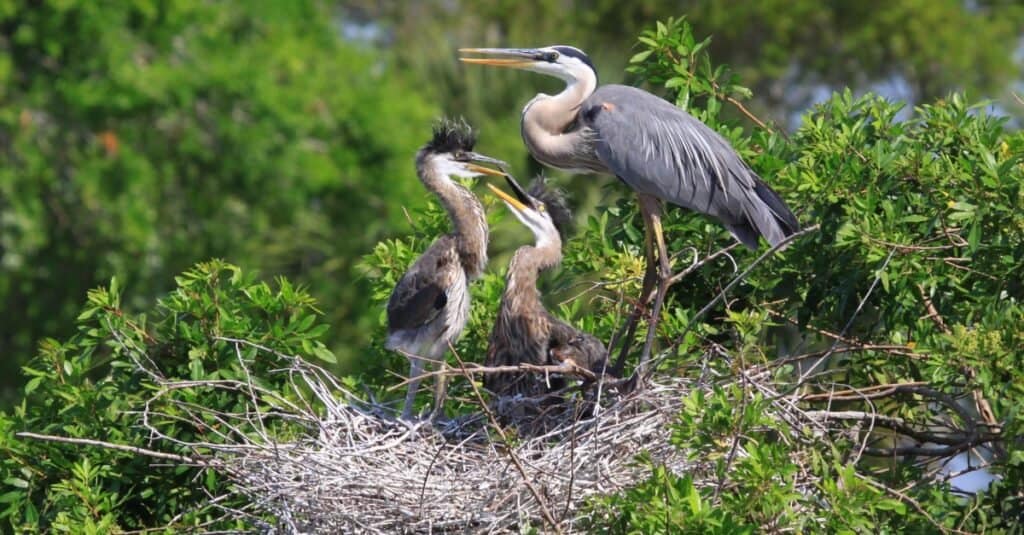
It’s not uncommon for great blue herons to build their nests at heights of up to 100 feet.
©Wolf Mountain Images/Shutterstock.com
6. Great Blue Herons Pant to Stay Cool
Different animals utilize different methods to stay cool in hot weather. While some animals cover themselves in mud, others sweat or vent heat from parts of their body. Great blue herons have their own way of staying cool if the sun is particularly strong.
In hot weather, you can often find great blue herons standing with their beaks open and wings drooped. To stay cool, they engage in a process called gular fluttering, which involves fluttering the throat muscles. Gular fluttering increases evaporation and is similar to panting in dogs, making this one of the cooler great blue heron facts. Additionally, standing with drooped wings aids in air flow, thereby allowing great blue herons to expel more heat.

To stay cool, great blue herons engage in a process called gular fluttering.
©Jim Schwabel/Shutterstock.com
5. Great Blue Herons Are Faster Than They Look
When most people think of fast birds, they think of small birds of prey such as hawks or falcons. However, these aerial predators are not the only birds that can move quickly. Great blue herons are relatively light despite their size due to their hollow bones. They also possess a large wingspan, which allows them to generate a lot of power with each wing flap. As a result, they can reach speeds up to 35 miles per hour. They tend to fly with the neck close to the body in a distinctive “S” shape.
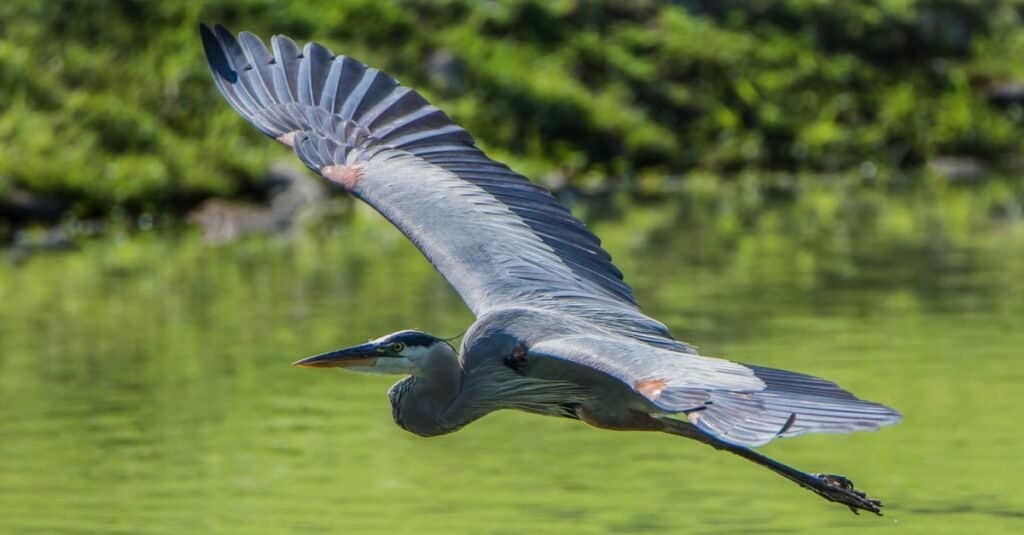
Great blue herons can reach speeds up to 35 miles per hour.
©Tom Franks/Shutterstock.com
4. Great Blue Herons Use Their Beaks Like Spears
Great blue herons usually hunt by wading through shallow water in search of food. You can often see them standing still or moving slowly as they stalk their prey. Sometimes they will also dive into the water from the air or a nearby perch, and they will also occasionally hunt on land. They locate their food by sight and typically swallow their prey whole.
However, they sometimes use their beaks in a different manner, especially when hunting larger or tougher prey. The neck of a great blue heron can stretch up to three times its normal length. This allows them to strike at prey from a distance. At times, they will use this trait to their advantage and use their beak like a spear to impale fish or frogs.

A great blue heron’s neck can stretch up to three times its normal length, allowing them to strike at prey.
©Eric Krouse/Shutterstock.com
3. Great Blue Herons Can Live Up to 25 Years
Great blue herons may not live as long as some parrot species, but their lifespan is by no means short. They reach sexual maturity at around 22 months, at which point young herons are considered adults. In the wild, great blue herons have an average lifespan of around 15 years. Most adult herons don’t live longer than 15 due to the number of predators and other threats that they face in the wild.
However, captive great blue herons could likely live much longer. For example, one great blue heron found in Texas was thought to be around 23 years old. If true, this means that great blue herons may have an age limit of up to 25 years.

In the wild, great blue herons have an average lifespan of around 15 years.
©Brian Lasenby/Shutterstock.com
2. Great Blue Herons Use Their Feathers Like a Washcloth
Birds are well-known for meticulously cleaning their feathers. Great blue herons take this habit to another level by using their own feathers like a washcloth. They grow unique feathers on the front of the chest that always grow and easily fray. While this sounds messy, they use these feathers to their advantage.
Great blue herons take a claw and comb these powdery feathers down the chest. The combing helps to remove scum and other debris and oils from the other feathers. Additionally, by combing the feathers onto their underparts, great blue herons help protect their other feathers from slime and oils common in swamp water.
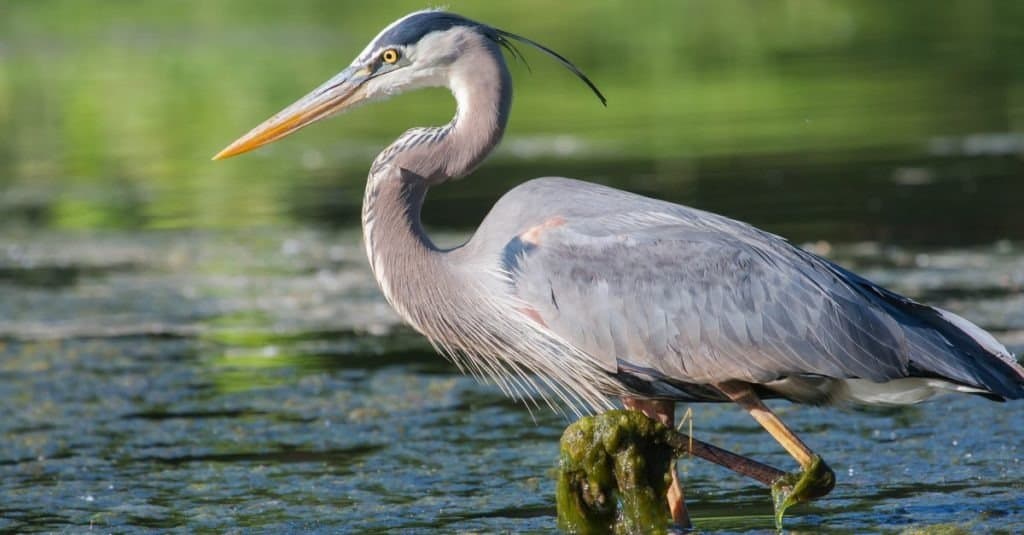
Combing its chest feathers helps the great blue heron remove scum, debris, and oils from itself.
©Joseph Scott Photography/Shutterstock.com
1. Some Great Blue Herons Look All White
As their name implies, great blue herons feature slate grey-blue flight feathers. Meanwhile, the thighs look red-brown, and the neck is reddish-grey, while the face looks almost white. However, there is a morph that looks almost entirely white, known as the great white heron.
Great white herons live only along the coasts of southern Florida, the Caribbean, and the Yucatan Peninsula. Some researchers debate that the great white heron is an entirely separate species, which would exclude it from our list of great blue heron facts. Regardless, these all-white herons are truly a sight to behold.

There is a morph of the great blue heron that looks almost white, known as the great white heron.
©Brian Lasenby/Shutterstock.com
The photo featured at the top of this post is © ttomasek15/Shutterstock.com
Thank you for reading! Have some feedback for us? Contact the AZ Animals editorial team.






